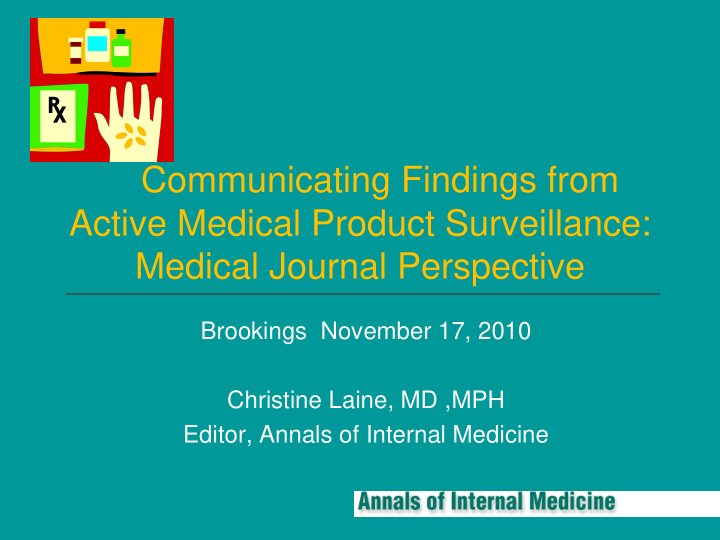



Communicating Findings from Active Medical Product Surveillance: Medical Journal Perspective Brookings November 17, 2010 Christine Laine, MD ,MPH Editor, Annals of Internal Medicine
What do journals offer medical product surveillance studies? • Independent peer review, can increase confidence in findings • Improvements in clarity of presentations • Dissemination to providers and media via a familiar medium • Mechanisms for comments, corrections, links to related information • Archiving of reports in common databases
Difficulties journals might pose for surveillance studies? • Restricted access to full reports • Delays due to time needed for careful peer review and journal production processes • Journals often request revisions, these revisions sometimes alter or temper conclusions • Journal standards for analysis and reporting may differ from FDA standards
How to best balance? • FDA’s need for rapid but responsible communication • Public’s need for valid, reliable information • Journals’ need not to publish “old news” • Researchers’ need for traditional academic publications
Preparing Stakeholders • Introduce clinicians and others to methods common in studies of medical surveillance and their critical appraisal • Develop and implement reporting standards for various types of surveillance studies (EQUATOR) • Educate stakeholders about data limitations, ad hoc queries vs. planned evaluations, non- reviewed vs. peer-reviewed reports, observational vs. experimental data
Stang et al. Annals of Internal Medicine. November 2, 2010.
Speeding Peer Review • Pre-submission review of study protocols for more complicated studies • Develop special formats that allow for rapid publication of simple descriptive studies • Develop fast track review processes • Submit protocols, statistical code, and data to journals with manuscripts • Adequate study staffing to enable rapid response to journal requests for revision • Routine early e-publication
Strategies for Responsible Reporting • Develop distinct formats for release of non- peer reviewed results, flag as preliminary • Avoid sensational language that implies safe/unsafe, communicate safety as a balance of benefits and harms • Clear reporting with full explication of study limitations, cautions • Promote data sharing for confirmation of findings and systematic reviews/meta- analyses
Recommend
More recommend